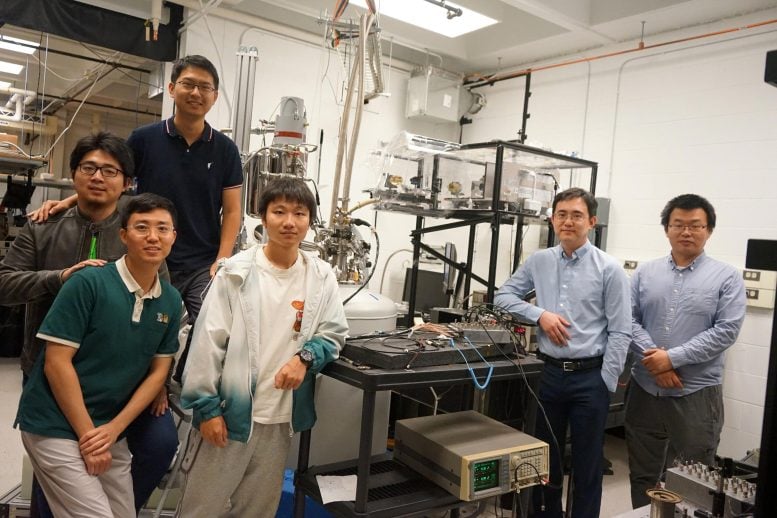from

Artist’s rendering of a newly discovered highway for electrons to occur in rhombohedral graphene. “We found a gold mine, and every spoonful is revealing something new,” says MIT Assistant Professor Long Ju. Credit: Sampson Wilcox/Electronics Research Laboratory
myth physicists have developed a new form of graphenecreating a five-lane electronic highway that allows ultra-efficient movement of electrons without energy loss.
This breakthrough in five-layer rhombohedral graphene could transform low-power electronic devices and works via the anomalous quantum Hall effect in zero magnetic field.
MIT physicists and their collaborators have created a five-lane highway for electrons that could allow ultra-efficient electronics and more.
The work, recently reported in the journal scienceis one of several important discoveries by the same team over the past year involving a material that is a unique form of graphene.
“This discovery has direct implications for low-power electronic devices because no energy is lost during electron propagation, which is not the case in ordinary materials where electrons are scattered,” says Long Ju, an assistant professor in the Department of Physics. and the corresponding author of science paper.
The phenomenon is similar to cars traveling on an open expressway, as opposed to those driving through neighborhoods. Neighborhood cars may be stopped or slowed by other drivers making sudden stops or U-turns that impede a smooth ride.
A New Material: Rhombohedral Graphene
The material behind this work, known as rhombohedral pentalayer graphene, was discovered two years ago by physicists led by Yu. “We found a gold mine, and every spoonful is revealing something new,” says Yu, who is also affiliated with MIT’s Materials Research Laboratory.
In one Nanotechnology of nature In a paper last October, Yu and colleagues reported the discovery of three important properties arising from rhombohedral graphene. For example, they showed that it can be topological, or allow the unhindered movement of electrons around the edge of the material but not through the middle. This resulted in a highway, but required the application of a large magnetic field about tens of thousands of times stronger than Earth’s magnetic field.

Six of the MIT physicists who created a five-lane highway for electrons are graduate students (left to right) Jixiang Yang, Junseok Seo and Tonghang Han; visiting university student Yuxuan Yao; Assistant Professor Long Ju; and postdoc Zhengguang Lu. Credit: Shenyong Ye
Enhancement of graphene electronic channels
In the current work, the team reports the creation of the highway without any magnetic field.
Tonghang Han, an MIT graduate student in physics, is co-first author of the paper. “We are not the first to discover this general phenomenon, but we did so in a very different system. And compared to previous systems, our system is simpler and also supports more electronic channels.” Explains Ju, “other materials can only support one lane of traffic at the edge of the material. Suddenly we raised it to five.”
Co-first authors of the paper who contributed equally to the work are Zhengguang Lu and Yuxuan Yao. Lu is a postdoc in the Materials Research Laboratory. Yao conducted the work as a visiting undergraduate student from Tsinghua University. Other authors are MIT physics professor Liang Fu; Jixiang Yang and Junseok Seo, both MIT graduate students in physics; Chiho Yoon and Fan Zhang from the University of Texas at Dallas; and Kenji Watanabe and Takashi Taniguchi of the National Institute for Materials Science in Japan.
How does it work?
Graphite, the main component of pencil lead, consists of many layers of graphene, a single layer of carbon atoms arranged in hexagons that resemble a honeycomb structure. Rhombohedral graphene consists of five graphene layers stacked in a specific overlapping order.
You and colleagues isolated rhombohedral graphene thanks to a new microscope You built at MIT in 2021 that can quickly and relatively inexpensively determine a number of important characteristics of a material in nanoscale. Stacked five-layer rhombohedral graphene is only a few billionths of a meter thick.
In the current work, the team tinkered with the original system, adding a layer of tungsten disulfide (WS2). “Interaction between WS2 and five-layer rhombohedral graphene resulted in this five-lane highway that operates in zero magnetic field,” Yu says.
Comparison with superconductivity
The phenomenon that the Ju group discovered in rhombohedral graphene that allows electrons to travel without resistance in zero magnetic field is known as the anomalous quantum Hall effect. Most people are more familiar with superconductivity, an entirely different phenomenon that does the same thing but occurs in very different materials.
He notes that although superconductors were discovered in the 1910s, it took about 100 years of research to get the system to work at the higher temperatures needed for applications. “And the world record is still well below room temperature,” he notes.
Similarly, graphene’s rhombohedral highway currently operates at about 2 kelvins, or -456 degrees Fahrenheit. “It will take a lot of effort to raise the temperature, but as physicists, our job is to provide insight; another way to accomplish this [phenomenon]”, says You.
Implications and future perspectives
The discoveries involving rhombohedral graphene came as a result of painstaking research that was not guaranteed to work. “We tried many recipes over many months,” says Han, “so it was very exciting when we cooled the system to a very low temperature and [a five-lane superhighway operating at zero magnetic field] it just came out.”
Says Ju, “it’s very exciting to be the first to discover a phenomenon in a new system, especially in a material we’ve discovered.”
Reference: “Large quantum anomalous Hall effect in spin-rough rhombohedral graphene” by Tonghang Han, Zhengguang Lu, Yuxuan Yao, Jixiang Yang, Junseok Seo, Chiho Yoon, Kenji Watanabe, Takashi Taniguchi, Liang Fu, Jug Lo, Zhang and May 9, 2024, science.
DOI: 10.1126/science.adk9749
This work was supported by a Sloan Fellowship; US National Science Foundation; US Office of the Under Secretary of Defense for Research and Engineering; Japan Society for the Promotion of Science KAKENHI; and Japan’s Prime Minister’s Global International Research Initiative.
#MIT #physicists #create #fivelane #quantum #highway #electrons
Image Source : scitechdaily.com
